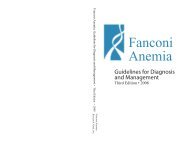FA Family News 3/01 - Fanconi Anemia Research Fund
FA Family News 3/01 - Fanconi Anemia Research Fund
FA Family News 3/01 - Fanconi Anemia Research Fund
Create successful ePaper yourself
Turn your PDF publications into a flip-book with our unique Google optimized e-Paper software.
New Molecular Diagnostic Services Offered to <strong>FA</strong>-A Families<br />
Considering Prenatal Genetic Diagnosis (PGD)<br />
To date, families pursuing prenatal<br />
genetic diagnosis (PGD) have been<br />
in complementation group C, which<br />
accounts for 15% of all <strong>FA</strong> families.<br />
This technology has not yet been an<br />
option for patients in <strong>FA</strong>-A, which<br />
accounts for 60-65% of <strong>FA</strong> patients.<br />
For PGD to work, scientists must<br />
examine one cell in each pre-embryo to<br />
see if it is a normal or <strong>FA</strong> affected cell.<br />
This is relatively easy to do with <strong>FA</strong>-C.<br />
The <strong>FA</strong>NCC gene is of average size. In<br />
addition, there are six common mutations<br />
in the <strong>FA</strong>NCC gene which cause<br />
<strong>FA</strong>. Scientists can screen rapidly for<br />
the presence of these six mutations.<br />
Almost all <strong>FA</strong>-C families have these<br />
common mutations.<br />
In contrast, the <strong>FA</strong>NCA gene is very<br />
large. Most of the disease mutations<br />
in this gene are private, or specific to<br />
only one family. There is no rapid,<br />
accurate test to locate a family’s specific<br />
mutations. Therefore, the mutations<br />
in <strong>FA</strong>NCA are not amenable to<br />
the same type of analysis as are the<br />
mutations in <strong>FA</strong>NCC.<br />
Sherri J. Bale, PhD, Clinical Director<br />
of Gene Dx, Inc., states that it is<br />
possible to use genetic markers to determine<br />
if one cell is healthy or not.<br />
<strong>FA</strong>NCA is on chromosome 16. Each<br />
<strong>FA</strong> carrier has two copies of chromosome<br />
16, one normal and the other<br />
carrying a disease mutation. Using<br />
genetic markers, it is possible to determine<br />
which chromosome 16 from each<br />
parent was inherited by the <strong>FA</strong> patient.<br />
This approach is often called “linkage<br />
analysis” because scientists are determining<br />
which genetic marker is<br />
“linked” to the mutation in the gene,<br />
without actually identifying the mutation<br />
itself.<br />
The procedure is very simple. DNA<br />
from both parents, the <strong>FA</strong> patient, and<br />
any healthy siblings is “typed” at several<br />
genetic markers. This information is<br />
then used by the in vitro laboratory to<br />
test fertilized embryos prior to implantation.<br />
In many cases it will be possible<br />
to determine with a very high<br />
degree of accuracy whether or not an<br />
embryo has inherited the chromosomes<br />
carrying the disease mutations from<br />
each parent.<br />
GeneDx, Inc. of Rockville, MD, is<br />
now providing linkage analysis to <strong>FA</strong>-<br />
A families in which there is at least one<br />
living patient with the disease, and<br />
both parents are available for genetic<br />
studies. It is also helpful if there are<br />
unaffected siblings of the <strong>FA</strong> patient<br />
who can be studied, as this can increase<br />
the accuracy of the analysis. The analysis<br />
is done in the laboratory on DNA<br />
obtained from a simple cheek swab,<br />
which can be collected at home using<br />
materials provided by GeneDx, Inc.<br />
At this time, the cost to perform this<br />
analysis on parents, the <strong>FA</strong> patient,<br />
and any unaffected siblings is $1,500.<br />
GeneDx. Inc. is a full-service genetic<br />
testing and diagnosis company dedicated<br />
to serving the diagnostic and<br />
genetic counseling needs of individuals<br />
and families with rare hereditary<br />
disorders. For further information contact<br />
Sherri Bale, PhD, <strong>FA</strong>CMG, Clinical<br />
Director, GeneDx. Inc. at 240-<br />
453-6285. ◆<br />
Preimplantation Genetic Diagnosis for <strong>Fanconi</strong><br />
<strong>Anemia</strong> at the Reproductive Genetics Institute<br />
The Reproductive Genetics Institute<br />
(RGI) in Chicago, Illinois has had<br />
extensive experience in preimplantation<br />
genetic diagnosis (PGD). They<br />
have worked with over 1,000 couples.<br />
Over 2,000 in vitro fertilization (IVF)<br />
cycles have resulted in more than 200<br />
healthy children. PGD with IVF and<br />
embryo transfer is done as part of an<br />
experimental study.<br />
Over the past two years, the RGI<br />
has included HLA diagnosis of<br />
embryos for the purpose of cord blood<br />
stem cell or bone marrow transplantation.<br />
The Nash family was their first<br />
successful attempt using PGD which<br />
resulted in a transplant. RGI will continue<br />
to offer its services to other <strong>FA</strong><br />
families.<br />
In the Nash family, the specific<br />
mutation in <strong>FA</strong>NCC was known. The<br />
same techniques can be used with<br />
embryos to detect a specific known<br />
mutation in <strong>FA</strong>NCA. When the mutation<br />
is not known, it is often possible<br />
to use linked genetic markers and family<br />
studies (linkage analysis) to predict<br />
if an embryo has inherited both the<br />
mother’s and the father’s mutations.<br />
RGI is willing to work with families<br />
in complementation groups A and<br />
C. Another laboratory must first assign<br />
a family to a complementation group.<br />
Parents, the <strong>FA</strong> patient, and unaffected<br />
siblings need to be HLA-tissue<br />
typed. It is very useful to the Reproductive<br />
Genetics Institute if another<br />
laboratory has determined a patient’s<br />
specific <strong>FA</strong> mutations.<br />
In some instances when the specific<br />
mutations cannot be determined,<br />
the RGI may develop linkage analysis<br />
for a family. This analysis would take<br />
8 to 10 weeks. The cost of developing<br />
a system to diagnose both <strong>FA</strong> and HLA<br />
in embryos is $4,000.<br />
In addition, the cost is $5000 per<br />
in vitro fertilization cycle ($2,500 to determine<br />
if the embryos are <strong>FA</strong> affected<br />
continued on page 19<br />
6 <strong>FA</strong> <strong>Family</strong> <strong>News</strong>letter

















